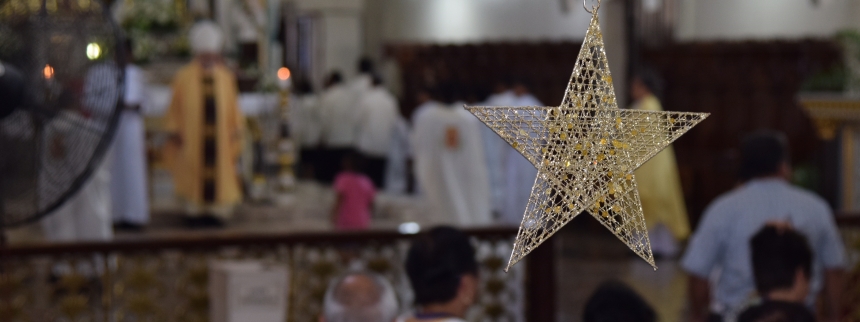
Following is Bishop Jaime Soto's Homily from the Feast of the Epiphany, which he celebrated at the Metropolitan Cathedral of the Conversion of St. Paul the Apostle in Vigan City located in the province of Ilocos Sur.
---
One of the fascinating, more indigenous cultural features of Christmas in the Philippines is the obsession with the star. The Christmas star is part of the Christmas legacy wherever you go but, it is safe to say, the Christmas star is the prominent symbol of the season here among the Philippine Islands.
Regrettably, there is much competition in today’s globalized version of Christmas. Yet Christmas trees, Santa Claus surrounded with snow, evergreen garland draping doorways, seem out-of-place. The Filipino Parol is still the dominantly prevalent Filipino icon. Today’s gospel reading from the narration of Matthew is the source for much of the fascination given to the star in Filipino culture.
Spanish culture til this day still prominently celebrates the Feast of Epiphany or as it is know there, the Feast of the Reyes Magos (the wise kings). Like the many strong indigenous cultures in Latin America, the Filipinos took the inspiration from the early Spanish missionaries and elaborated their own mestizo expression, the Parol, from the Spanish “Farol”, meaning lantern.
Like many cultural and religious symbols there is a narrative. The narrative of Matthew is a rich, dramatic one (Mt. 2.1-12). Something to note, the magi are the only ones who took note of the star and its significance. Herod and all of Jerusalem did not see or failed to give it another thought until the magi arrived. At that time, the Jews were obsessed with the lunar calendar. This was the center of their nocturnal study. The stars were the stuff of the unbelievers.
The magi were gentiles, unbelievers. Jews were not to have more than limited contact or risk being judged unclean. That these unbelievers came looking for the newborn king of the Jews was more than most people could put their head around.
From the very beginning then, Jesus had a universal appeal. He spoke not just to the Jewish heart but the human heart, the human heart hungry for God. His Coming has consequences for all of human history.
The image of the star spoke a language that was scientific, poetic, aesthetic, romantic, and yet always mysterious. We can say that the star is primordial, from the very beginning of the world. The psalmist tried to capture this in the 19 psalm, “The heavens declare the glory of God; the firmament proclaims the works of his hands. Day unto day pours forth speech; night unto night whispers knowledge. There is no speech, no words; their voice is not heard.”
Their voice was not heard until the magi, completely foreign to the covenant with Abraham, saw a message in a star or were entranced by its alluring glow and went in pilgrimage in search for the glory of God of which the star was but a glimmer.
This was another jarring feature of Matthew’s Christmas narrative. Jerusalem was the place of pilgrimage. How could it be that the newborn was not there? Like the shepherds in the account of Luke, the pilgrimage leads to a person and not a place. What they would have done in the temple of Jerusalem, the magi fulfilled in the humble abode of Joseph where the child was still in the arms of his mother, Mary. They prostrated themselves and did him homage. They made offerings of gold, frankincense and myrrh. Jesús was new destination of the human journey. More than that, he is the companion on the journey as stars so often accompanied sailors and travelers long ago.
St. John Paul II referred to Mary as the Star of the New Evangelization. This is an interesting Marian association of the star from Matthew with the still urgent call to evangelize. John Paul was emphatic in saying that Jesus is the same yesterday, today, and forever but the new evangelization must look for new expression, new methods, and new vigor. The metaphor of a star brings together creation and culture as powerful languages that God continues to use to communicate His tender, timeless mercy.
As is true for most Christmas metaphors, there is an element of hope as well as challenge in the metaphor of the Christmas star, a joy that is generous. Upon seeing the star the magi were overjoyed. This joy led them to worship and sacrifice the best of what they had to the Son of Mary.
The Filipino Parol is part of the unfinished story of the magi. We do not know what became of those ancient wise kings. This was probably the evangelist’s intention because the work of evangelization is never finished.
Evangelization has always been a challenge. We have our own challenges today. The Parol speaks of a mysterious beauty that is attractive, alluring and accompanying. It does not make much argument except in reflecting God’s own beauty. There is a place for debate, dogmas, and doctrines when communicating the faith. These are all important. Still, in the end everyone must feel the attraction of the person of Jesus, the dawning sun whose light will never diminish. We must learn for the Parol how to make the light of the gospel shine so that others may join us in the pilgrimage of faith and charity, because someday we are all going to see the King.
---
Click here for a Facebook photo album that follows Bishop Soto's journey in the Philippines.
Did you miss a dispatch? Find them all here: First | Second | Third | Fourth | Fifth | Sixth | Seventh

